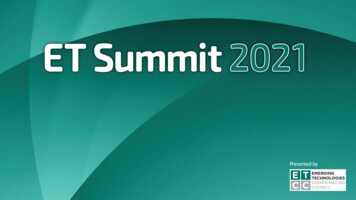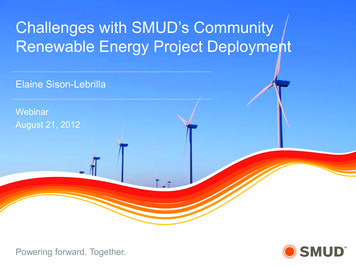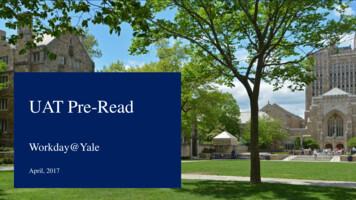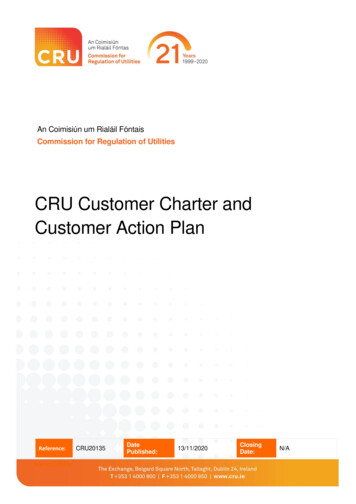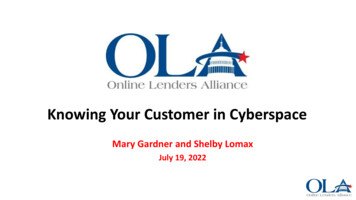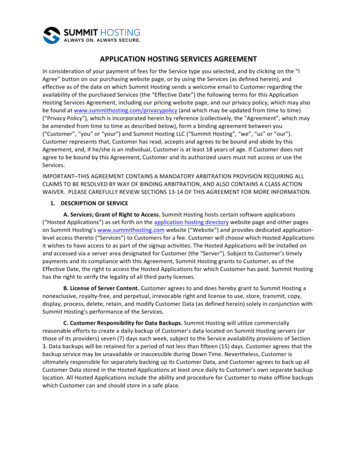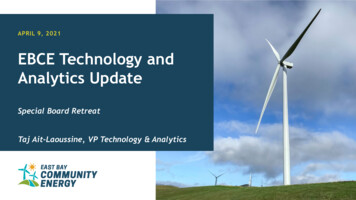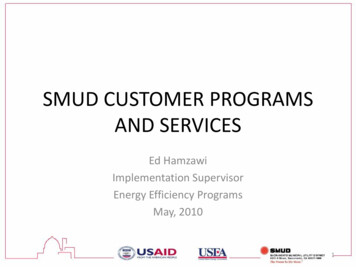
Transcription
SMUD CUSTOMER PROGRAMSAND SERVICESEd HamzawiImplementation SupervisorEnergy Efficiency ProgramsMay, 20101
Customer Programs & Services1.2.3.4.5.Vision and BackgroundEnergy Efficiency ProgramsSolar/PV ProgramsResidential Assistance ProgramsRevenue/Customer Service Programs
Vision Statement“SMUD’s vision is to empower ourcustomers with solutions and optionsthat increase energy efficiency, protectthe environment, reduce globalwarming, and lower the cost to serveour region.”
Programs and Services Drivers Customer Needs– Information– Bill Management– Assistance Board Goals and Strategic Directives– SD-5 Customer Relations– SD-7 Environmental Leadership– SD-9 Resource Planning Legislation– AB2021 (Energy Efficiency and Resource Planning)– AB32 (Carbon Reduction)– SB1 (Solar Incentives)
General Program or Service LifecycleEvaluationImplementationMarket ResearchPlanning
Program Planning and Design Criteria Financial Considerations–––– Market Considerations––––– Available Budget and Overall CostCost Effectiveness or ROIInternal vs. External Labor CostsTechnology/Investment CostsNeeds/Opportunity AssessmentCustomer SegmentCurrent and Future PotentialFeasibility vs. AcceptanceMarket BarriersImplementation Models––––Incentive StructureRegional CoordinationPartnership OpportunitiesMarketing and Advertising
Measurement & Verification Focused on Energy Efficiency Programs– Program rotation schedule utilized to evaluate programs on a 3-year cycle, due tolimited budget and resources– Priority given to larger and more complex programs– New or modified programs included in mix early to allow for adjustments relativelyquickly in the program cycle Conducted Primarily by Independent Third Party Evaluation Contractors– Impact evaluations supervised and directed by SMUD Resource Planning group– Process evaluation or customer satisfaction research conducted or managed internallyor by Market Research group M&V Protocols and Methodology– Evaluation criteria use industry standards defined in the California Evaluation Frameworkdeveloped in 2004– Methodologies utilized are established in the California Energy Efficiency EvaluationProtocols and the California Public Utilities Commission’s Load Impact Estimation forDemand Response: Protocols and Regulatory Guidance
Energy Efficiency Programs Energy Efficiency Portfolio 10-Year Plan 2010 Energy Efficiency Program Portfolio Energy Efficiency Information/Education Programs–––– Residential AdvisoryHome Energy DisplayHome Energy ReportsEnergy & Technology CenterExisting Home Energy Efficiency Programs– Appliance Efficiency– Equipment Efficiency ––––Energy Efficiency LoansWhole House PerformanceConsumer ElectronicsRetail LightingMulti-Family Retrofit
Energy Efficiency Programs (Cont’d) Existing Commercial Energy Efficiency Programs––––– Customized IncentivesExpress Efficiency IncentivesRetro-CommissioningDistributor IncentivesPrescriptive Lighting IncentivesShade Tree Program– Sacramento Shade Community ShadeNew Construction Energy Efficiency Programs– Residential Solar Smart Energy Efficiency– Residential Advantage Home– Commercial Savings By Design
10-Year Energy Efficiency Goals Updated plan recently adopted by the SMUD Board Savings goals represent 1.5% of current energy forecast
2010 PLANNED ENERGY EFFICIENCY PROGRAM PORTFOLIOBudgetProgramIncentivesEnergy Efficiency Information/EducationResidential AdvisoryHome Energy DisplayHome Energy ReportsTotal EE Information/Education Total Avg. Life(yrs)Levelized Levelized /akWcents/kWh 1,052,263 142,660 565,861 5342999571410.675.7715.73 1,587,560 3,469,726 1,273,612 2,344,103 2,845,245 1,771,117 382.8312.744.262.789.10048.7008.91502.80 1,325,9650.2000.40020.057828.90382,500 1,247,266150,000 424,621466,500 1,716,668999,000 8.018.015.015.111523928815857.6039.222.725.10Total Programs & Services 15,244,000 28,953,49824.500142.6008.31853.18Planning 1,505,677New Product Development 363,732Market Research 752,974Marketing 601,384Energy & Technology Center 836,085Measurement & Evaluation 713,751EE R&D - Emerging Technologies 1,034,023Total Strategy 5,807,626ENERGY EFFICIENCY TOTALS 15,244,000 34,761,12424.5142.68.32223.82-Existing Home Energy EfficiencyAppliance EfficiencyEquipment EfficiencyWhole House PerformanceConsumer ElectronicsRetail LightingMulti-Family RetrofitTotal Existing Home EE Commercial Retrofit Energy EfficiencyCustomized IncentivesExpress Efficiency IncentivesRetro-CommissioningDistributor IncentivesPrescriptive Lighting IncentivesCommercial Standard Performance ContractsTotal Commercial Retrofit EE 1,200,000 825,000 550,000 2,400,000 4,975,000 Shade Trees (Sacramento Shade)New Construction Energy EfficiencyResidential Solar Smart Energy EfficiencyResidential Advantage HomeCommercial Savings By DesignTotal New Construction EE ,270,000
Energy Efficiency Information/Education Residential Advisory – Offers a broad range of educational, advisory, andtechnical assistance services to help single-family homeowners improvethe efficiency of their homes– Telephone assistance and advice– On-line information and energy auditing tools– In-home energy audits under selected circumstances Home Energy Display – Provides a means to show customers real-timeinformation about electricity use and cost in customer homes– In home monitor linked to meter to show cumulative usage and estimated bill amount– Technology currently in flux as we transition to Smart Meters
Energy Efficiency Information/Education(Cont’d) Home Energy Reports (pilot) – Increases awareness of electricityconsumption by comparing customers’ electricity usage to their neighborsas well as to their personal historical usage, and offers tips to reduceelectricity usage.– Current pilot includes approximately 35,000 residential customers– If successful, the report will be incorporated into the portfolio on a permanentbasis and rolled out to additional households Energy & Technology Center – Provides educational seminars, classes, andcertification programs for residential and commercial customers,contractors, designers, and other market actors on a wide variety of topics
Existing Home Energy Efficiency Appliance Efficiency - Increases market penetration of high-efficiencyappliances, removes inefficient ones from the market, and increasesconsumer education on how to maximize operating efficiency and savingsfrom equipment use Equipment Efficiency - Increases the energy efficiency of homes andreduces customer electric bills by improving the efficiency of the buildingenvelope, heating, cooling, and water-heating equipment on a measureby-measure basis– Energy Efficiency Loans - Provides fixed interest installment loans forresidential, commercial, and multi-family property owners to install energyefficient (EE) equipment [and photovoltaic (PV) systems]– Provides contractors with a sales tool to help customers overcome theincremental costs of EE and increase participation in our programs
Existing Home Energy Efficiency (Cont’d) Whole House Performance (Home Performance with Energy Star) –Utilizes a building science and measurement approach to enable acomprehensive means of assessing the performance and comfort ofhomes as a system, diagnose problems, and identify and implementsolutions to maximize energy savings– New Program for 2010, currently in final stages of development with launchexpected in June– Provides higher levels of energy efficiency, greater comfort, and lower utilitybills than component-based rebate programs– Utilizes a third-party program administrator to recruit, educate, certify, assurejob quality, and oversee the field work of trade/installation contractors, as wellas provide marketing and reporting functions
Existing Home Energy Efficiency (Cont’d) Consumer Electronics - Seeks to promote and increase the marketpenetration of high-efficiency electronics products in residential homes(and businesses).– Partnership agreement with other utilities to leverage regional and nationalmarketing power. The partnership has established participation agreementswith retailers and Original Equipment Manufacturers (OEMs) to provideincentives for manufacture, distribution, and sale of certain high efficiencyproducts– The program currently supports TV’s, computer monitors, and computers thatmeet or exceed specified Energy Star efficiency ratings and requirements Retail Lighting – Seeks to increase market penetration of high-efficiency(Energy Star) compact fluorescent bulbs and fixtures in residentialhouseholds– Provides incentives to manufacturers on a per bulb or fixture basis to discount and sellhigh efficiency lighting products through local retail outlets to consumers
Existing Home Energy Efficiency (Cont’d) Multi-Family Retrofit – Intended to capture significant energy savingspotential in existing apartment and condominium dwelling units andcommon areas– Difficult market segment to penetrate because of the “split-incentive” wherethe benefits of lower energy bills are not directly accrued by property ownerswho must make the investments in equipment associated with energyefficiency projects.– Provides prescriptive incentives to contractors (or property owners if selfinstalled) for the installation of a wide variety of efficiency measures thatmeet minimum efficiency and installation specifications– Project applications completed and submitted by contractors or owners toprogram manager for approval and payment upon completion of work subjectto inspection and verification
Existing Commercial Energy Efficiency Customized Incentives - Provides energy information, consultationservices, and financial incentives for implementation of high efficiencyretrofits in commercial facilities– Enables commercial customers to use energy more efficiently, reduceindustrial energy costs per unit of output, and manage their energy use andutility costs Express Efficiency Incentives - Provides fixed or prescriptive-basedincentives for the installation of eligible efficiency measures in customerfacilities. Example measures include: Air-Conditioning Equipment Food Service Equipment Refrigeration Equipment Network PC Management
Existing Commercial Efficiency (Cont’d) Retro-Commissioning - Designed to obtain cost-effective energy savingsand reductions in peak demand in commercial buildings by fine-tuningenergy control systems and ensuring optimal operation of major energyusing equipment Distributor Incentives - Provides incentives to distributors of HeatingVentilating and Air Conditioning (HVAC), and Motors to encourage thedistribution and sales of high efficiency equipment Prescriptive Lighting Incentives - Provides incentives primarily to smallcommercial customers ( 300kW) to encourage the installation of highefficiency lighting systems in this hard-to-reach market segment
Shade Trees (Sacramento Shade)& Community Trees The Shade Tree program facilitates planting of trees that directly shadebuildings, thus reducing summer air conditioning loads The Community Trees (CT) program strives to plant trees in public places,such as schools, parks and streets– Additional objectives include creating an urban forest to mitigate summerheat-island effects, improving the region’s air quality, and carbonsequestration– Program is delivered via a cooperative agreement with the Sacramento TreeFoundation, a local not-for-profit organization.– SMUD administers and markets the program and the Sacramento TreeFoundation (on a contract basis) assesses and makes tree-sitingrecommendations, and delivers trees to customers
New Construction Energy Efficiency Residential Solar Smart – Provides financial incentives to builders toincorporate energy efficiency along with integrated solar PV rooftopsystems into new home construction Residential Advantage Home – Provides incentives to builders toincorporate energy efficiency features in new homes that exceedminimum required standards– Program is sun setting to be fully replaced with Solar Smart at the end of 2010 Commercial Savings By Design – Provides design and constructionincentives to designers, architects, and developers to incorporate energyefficiency features in commercial new construction projects– Part of a Statewide California program to provide a consistent implementationmodel and program platform
Solar/PV Programs History, Background and 10-Year Goal Programs:–––––Residential Retrofit PVCommercial PVSolar Smart PV (residential new construction)Solar SharesCommunity Solar
SMUD Solar Programs - HistoryTwo Decades of Solar Leadership Nearly 2000 Installations ofdistributed PV systems– Residential new home and retrofitapplications– Neighborhood PV (Non-Profits)– Commercial (Large & Small)– Utility-Scale systems
Solar Program – 10-Year Goal California statewide goal of 3,000 MW of customer-installedsolar PV systems over 10 years via legislation passed in 2007 SMUD portion of this is 125 MW with a 130 millioncommitment over 10 years– Solar surcharge implemented in January 2008– 2010 Goal of installing 9.3 MW with a budget of 15.4M SMUD needs to install as much solar every year as we hadpreviously from 1984 through 2006 Up front rebates provided for system installation (in adeclining block manner over time) or via performance-basedincentives payable monthly over a fixed contract term
2007 - 2016 IncentivesINCENTIVESStep 1Step 2Step 3Step 4Step 5Step 6Step 7Step 8Step 9Step 10Buy down ( /W) 3.00 2.50 2.20 1.90 1.55 1.10 0.65 0.35 0.25 0.20PBI 5-yr ( /kWh)NA 0.40 0.35 0.30 0.25 0.17 0.10 0.06 0.04 0.03PBI 10-yr ( /kWh)NA 0.24 0.21 0.18 0.15 0.11 0.06 0.03 0.02 0.02GOALS - 53.53.03.54.55.06.08.1Res Retro0.10.50.51.01.01.01.51.52.03.1New Solar Homes4.53.03.02.52.02.53.03.54.05.0
Solar PV Programs Residential retrofit – Customer owned/contractor installedrooftop PV systems Commercial — Customer or third-party owned rooftop orparking lot PV systems (retrofit and new construction) SolarSmart New Homes — PV systems integrated into thedesign and construction of new tract homes SolarShares — Customer buys share of solar farm built bythird party and power sold to SMUD Community Solar — PV installed on community-basedprojects such as Habitat For Humanity and PV for schools
Residential Retrofit PV Average System Size: 3.4 kWAverage duration: 15 weeksAverage Install Cost: 9.00/Watt# of Installs2007 61kW183Incentives 533,5002008 67203 514,5002009 207668 1.33M
Commercial PV Installations# of 4494,848 290,000 948,00 4.3M 15M
Solar Smart New HomesTransforming the market to make solar part of all new homes builtin Sacramento Over 4,000 homes and nearly 10 MW subscribed450 completions since program inception in January 200711 Builder-PartnersAverage system size 2.5 kW
Solar Shares 1MW PV system built by SMUD via power purchase contractwith outside provider Marketed as an alternative to installing PV on rooftop Generation sold to customers as “virtual net metering” Sold out in six months to 700 customers
Large installations, no site issues, available toall residential customers, 20 year contractsAvailable to customers July 2008Fully subscribed Jan. 2009 – 1.5 kW avg.Virtual net-metering – monthly credits on billMonthly subscription fee based on capacitysize (.5kW – 4 kW) - 10.75 - 132/mo1 MW – 8 acres – solar thin film20-year PPA (power purchase agreement)3rd Party owned
Residential Assistance ProgramsGoal is to make the electric bills of our special needs customersaffordable and to provide assistance with managing usage andbills through a variety of methods Rate Assistance – (Energy Assistance Program Rate, Medical EquipmentDiscount Rate) Bill Assistance – (customer EnergyHelp donations, federally funded billpayments, local agency bill payments) Dwelling Assistance – (Weatherization, Refrigerator Program, CommunityPartners Program) Education & Outreach – (workshops, fairs, events, partnerships, multiplelanguages)
Revenue/Customer Service ProgramsDesigned to provide a variety of value-added services andoptions for customers based on market research aroundcustomer wants and needs Energy Profiler On Line - Commercial energy data for largecommercial/campus billed customers– 300 data points for 150 large customers Power Protection Service - Whole house surge protector-- 6.95 permonth– 5,000 customers; 650 new customers in 2009 HomePower - Minor electrical repair service-- 5.95 per month– 30,000 customers; 7,000 in 2009
Revenue/Customer Service Programs(Cont’d) Greenergy - Customers buy renewable energy for 3 or 6 per month or 10 per block for commercial– 44,000 enrolled; 18,000 new customers in 2009 Carbon Offsets - Customers can opt to purchase offsets to reduce theircarbon footprint based on their estimated household characteristics– Credits are used to construct local emission reduction projects– Mainstream program in 2009; 1,200 enrollments Moving Connections - Move-ins transferred to third party vendor forother service hookups in exchange for share of revenue– transfer rate of 60%--63,700 transferred last year Cell Site Leasing - Cell phone vendors lease transmitter space on SMUDpoles/towers– 16 current sites; 6 new sites in 2009
Measurement & Verification. Focused on Energy Efficiency Programs. - Program rotation schedule utilized to evaluate programs on a 3-year cycle, due to limited budget and resources - Priority given to larger and more complex programs - New or modified programs included in mix early to allow for adjustments relatively quickly in the program cycle. Conducted Primarily by Independent Third Party Evaluation Contractors.
